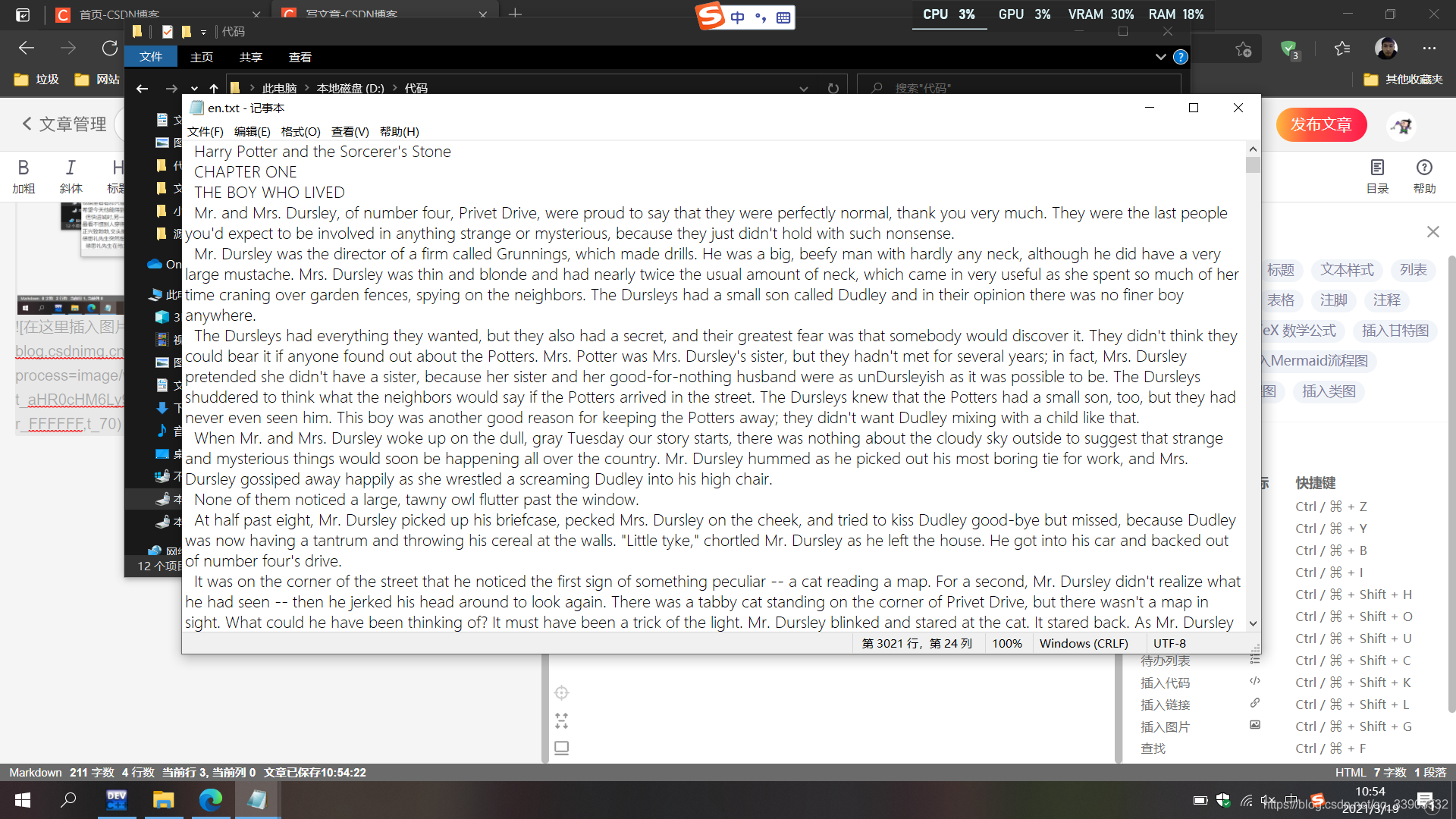文章目录
前言
网上下载的所谓中英对照文本往往都是中英分开的两个文本:


很鸡肋,所以在这里讲一下如何将其设置为一段中文一段英文。

一.首先要对网上下载的文件进行必要的修改
注意
下载的资源可能存在中文段数和英文段数不一致的情况,这会直接影响输出结果,所以还是建议大家将文章分为多个部分排版,然后整合。
1.将段与段之间的空行删除
先将全文赋值粘贴到Word文档中,全选文档,然后按Ctrl+H弹出替换框,输入如图所示的字符(一个^p表示一个换行符,它的意思就是将连续两个换行符替换为一个)

然后选择全部替换,多点击几次全部替换,以免有漏网之鱼。
替换完成后:

可以看到,段之间的空行消失了。
2.将每一段段首设置为两个空格(包括标题)
(1)将Word文档复制到文本文档中

(2)使用替换
文本编辑器的替换很简单很人性:

先复制每段前面的空格 ,然后全选,再点击替换,将复制的空格粘贴,输入替换内容为英文输入法下的两个空格(英文空格使用的是ANSIC码,会方便我们后面的操作)。将段首解决后解决标题,同样的复制粘贴加替换。
完成后:

3.将完成好的文本复制粘贴到编译器中(Dev c++)
如图:

这一步的目的是将Unicode编码转换为ANSIC编码(后面使用文件函数时会方便很多ANSIC)。
保存这串“代码”,以后的操作都是对这个保存的“代码”进行的。
英文文档也按上面的方法操作,最终得到两个拓展名为.cpp的文件,我将其分别命名为ch.cpp和en.cpp。
二.程序设计
1.基本思路
以英文文档为例:文章的每一段都以两个空格开始,所以可以存储每一段段首和段尾的位置(距离文章第一个字符的字节数),在输出时,按照每段从段首到段尾输出。
2.代码实现
(1)数据存储
将每段段首和段尾的位置存储在结构体中:
typedef struct passe{
long start;
long end;
struct passe *next;
}PassE;
typedef struct passc{
long start;
long end;
struct passc *next;
}PassC;
(2)使用链表存储所有段落的开始和结束位置
以英文为例:
for(i=0;;i++)
{
fseek(fp_e,i,SEEK_SET);
ch1=getc(fp_e);
ch2=getc(fp_e);
ch3=getc(fp_e);
if(ch1==EOF||ch2==EOF||ch3==EOF)
{
last_e=(PassE*)malloc(sizeof(PassE));
current_e->next =last_e;
last_e->next=NULL;
last_e->start =current_e->end;
last_e->end =ftell(fp_e);
break;
}
if(ch1==' '&&ch2==' '&&ch3!=' '&&i!=0)
{
end=i-1;
current_e=(PassE*)malloc(sizeof(PassE));
if(head_e==NULL)
{
head_e=current_e;
head_e->start=0;
}
else
{
previous_e->next=current_e;
current_e->start =previous_e->end ;
}
previous_e=current_e;
current_e->end =end;
current_e->next =NULL;
}
}
(3)输出文档
由于可能存在中文段数和英文段数不一致的情况,故在输出时需要判断中文和英文是否已经输出完毕,加入其中一个已经输出完毕,就结束关于它的操作(current_c->next=NULL,出现current_c=current_c->next,并且试图访问其中的数据的行为时,程序会异常退出)
while(true)
{
if(argu_e)
{
for(i=current_e->start ;i<=current_e->end ;i++)
{
fseek(fp_e,i,SEEK_SET);
ch=getc(fp_e);
fprintf(fp_immi,"%c",ch);
}
}
if(argu_c)
{
for(i=current_c->start ;i<=current_c->end;i++)
{
fseek(fp_c,i,SEEK_SET);
ch=getc(fp_c);
fprintf(fp_immi,"%c",ch);
}
}
if(current_c->next!=NULL)//此时current_c已经输出过了
current_c=current_c->next ;
else
{
argu_c=0;
}
if(current_e->next!=NULL)
current_e=current_e->next ;
else
{
argu_e=0;
}
if(argu_c==0&&argu_e==0)
break;
}
3.完整代码
#include<stdio.h>
#include<stdlib.h>
typedef struct passe{
long start;
long end;
struct passe *next;
}PassE;
typedef struct passc{
long start;
long end;
struct passc *next;
}PassC;
int main(void)
{
PassE *head_e=NULL,*current_e,*previous_e,*last_e;
PassC *head_c=NULL,*current_c,*previous_c,*last_c;
FILE *fp_e,*fp_c,*fp_immi;
fp_e=fopen("en.cpp","r+");
fp_c=fopen("ch.cpp","r+");
fp_immi=fopen("immi.txt","r+");
//获取英文字符
char ch1,ch2,ch3;
long end,i;
for(i=0;;i++)
{
fseek(fp_e,i,SEEK_SET);
ch1=getc(fp_e);
ch2=getc(fp_e);
ch3=getc(fp_e);
if(ch1==EOF||ch2==EOF||ch3==EOF)
{
last_e=(PassE*)malloc(sizeof(PassE));
current_e->next =last_e;
last_e->next=NULL;
last_e->start =current_e->end;
last_e->end =ftell(fp_e);
break;
}
if(ch1==' '&&ch2==' '&&ch3!=' '&&i!=0)
{
end=i-1;
current_e=(PassE*)malloc(sizeof(PassE));
if(head_e==NULL)
{
head_e=current_e;
head_e->start=0;
}
else
{
previous_e->next=current_e;
current_e->start =previous_e->end ;
}
previous_e=current_e;
current_e->end =end;
current_e->next =NULL;
}
}
for(i=0;;i++)
{
fseek(fp_c,i,SEEK_SET);
ch1=getc(fp_c);
ch2=getc(fp_c);
ch3=getc(fp_c);
if(ch1==EOF||ch2==EOF||ch3==EOF)
{
last_c=(PassC*)malloc(sizeof(PassC));
current_c->next =last_c;
last_c->next=NULL;
last_c->start =current_c->end;
last_c->end =ftell(fp_c);
break;
}
if(ch1==' '&&ch2==' '&&ch3!=' '&&i!=0)
{
end=i-1;
current_c=(PassC*)malloc(sizeof(PassC));
if(head_c==NULL)
{
head_c=current_c;
head_c->start=0;
}
else
{
previous_c->next=current_c;
current_c->start =previous_c->end ;
}
previous_c=current_c;
current_c->end =end;
current_c->next =NULL;
}
}
char ch;
current_e=head_e;
current_c=head_c;
int argu_c=1,argu_e=1;
while(true)
{
if(argu_e)
{
for(i=current_e->start ;i<=current_e->end ;i++)
{
fseek(fp_e,i,SEEK_SET);
ch=getc(fp_e);
fprintf(fp_immi,"%c",ch);
}
}
if(argu_c)
{
for(i=current_c->start ;i<=current_c->end;i++)
{
fseek(fp_c,i,SEEK_SET);
ch=getc(fp_c);
fprintf(fp_immi,"%c",ch);
}
}
if(current_c->next!=NULL)//此时current_c已经输出过了
current_c=current_c->next ;
else
{
argu_c=0;
}
if(current_e->next!=NULL)
current_e=current_e->next ;
else
{
argu_e=0;
}
if(argu_c==0&&argu_e==0)
break;
}
}
4.效果
前一部分:

结尾:


可以看到出现了对不上号的情况,所以在运行代码前尽量确保中英文每一个段落可以对应的上(对文档的每一章单独整理,处理好格式,它的工作量不大)。